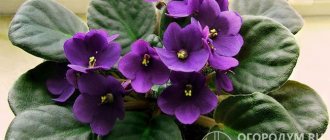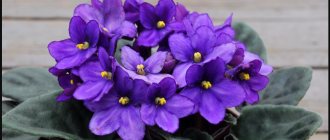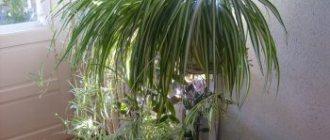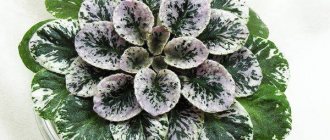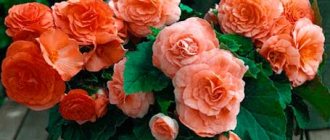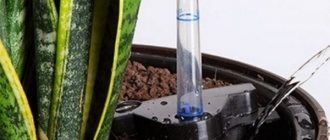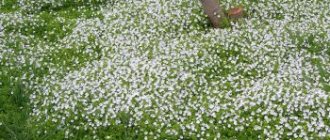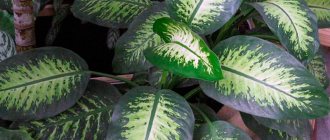- Yeast
A native of the tropical rainforests of Indonesia and America, spathiphyllum has long been established in houses and apartments as a houseplant. It is attractive with its shiny, ellipsoidal, long-petiolate leaves with clearly defined veins and unusual, beautiful inflorescences in the form of a cylindrical cob surrounded by a bract (veil). The flower cannot be called “easy” to care for. To achieve decorative foliage and regular flowering, you need to know where to place it, how to water it correctly, and how to feed the spathiphyllum.
Spathiphyllum Wallace produces arrows 20-25 cm long with white-cream-colored cobs and white bracts that turn green at the end of flowering
Today it is fashionable to talk about the energy of indoor plants. Some of them are considered useful in this regard, others are considered harmful and even dangerous. Spathiphyllum is called the flower of female happiness. The girl who received it as a gift will meet her love, be happy in her relationship, get married, and have children. Whether or not to believe such legends is a personal matter for everyone. It seems that avid flower growers, who are kind to their green “friends,” don’t even think about it.
When does the “female happiness” flower need feeding?
For the first time after transplantation, there is no need to feed spathiphyllum , since all the nutrients are provided by the substrate. Subsequently, as a result of soil depletion, the flower begins to lack useful elements. This is expressed as follows:
- slow growth and limp leaves – magnesium deficiency;
- pale color, small leaves, lack of flowering – lack of phosphorus;
- yellowing of individual leaf fragments - need for calcium;
- wilting of the plant and the appearance of yellowness on the leaf blades - the need for complex feeding.
There are situations when you should not rush to apply fertilizers:
- when damaged by pests;
- during the adaptation period;
- during the cold season;
- in case of root rot disease.
Important! The optimal time for fertilizing is summer and spring, at this time the procedure is carried out once every 7 days.
How to choose the right time?
How to determine that a plant needs fertilizer?
The first sign that a flower is “hungry” is a deterioration in appearance. A plant that has not been fed for a long time has a pale color, becomes smaller in size and does not bloom. Sometimes there is uneven yellowing of the foliage, as well as its drying out.
In more detail, each sign indicates a lack of one or another element.
For example:
- If a flower is stunted, it lacks magnesium. This may also be indicated by lethargy and loss of turgor.
- If the leaves of a flower turn yellow, this indicates that it has used up its vitality and needs comprehensive feeding.
- Yellow leaves with green veins are evidence that the plant is suffering from chlorosis and lacks iron.
- If the green pet is healthy, but does not bloom, this is a sign of potassium and phosphorus deficiency. In this case, you need to change the drug.
When should the procedure not be performed?
Cases when applying fertilizer is not recommended:
- If less than a month has passed since the transplant. In this case, fresh soil will provide the flower with everything it needs and it does not need fertilizing.
- You should not feed a plant that is sick or infested with pests.
- A newly purchased flower should not be fertilized, as this can cause serious stress to it. And a plant under stress may drop its buds or stop blooming altogether. The adaptation period after purchase is at least 2 months.
- During the cold season, the flower hibernates and does not need nutrition. During this period, the amount of fertilizer is minimized or not applied at all.
- If there is a suspicion that the flower is sick with root rot, fertilizing is not carried out. In this case, measures should be taken to treat the flower and then apply fertilizer.
What time of year is best to fertilize?
The most optimal time for feeding is the spring-autumn period. This is the time of active growing season after hibernation, when spathiphyllum is fertilized once a week.
The active growing season of spathiphyllum lasts from March to September.
How to fertilize a plant for abundant flowering?
Organic and mineral fertilizers are used as fertilizing. The following components should be included in the nutritional mixture :
- nitrogen;
- phosphorus;
- potassium;
- sulfur;
- manganese;
- boron;
- copper;
- iron;
- manganese.
This is what is used to make spathiphyllum bloom beautifully; the plant should be fed with these elements twice a year. Solutions for very young specimens should not have a strong concentration.
Inexperienced flower growers are recommended to use liquid formulations , since in this case it is easier to calculate the required dosage.
Before use, store-bought fertilizers are diluted with water in the ratio specified in the manufacturer’s instructions. In this case, the water must be distilled or boiled. After complete dissolution of the product, spathiphyllum is watered, strictly adhering to the norm. For foliar feeding, the concentration of the drug is reduced.
The dosage for spraying a plant should be 2-3 times lower than that indicated on the package.
There are the following options for feeding spathiphyllum::
- Liquid fertilizers intended for use during the flowering period.
- Special compositions for aroids.
- Products produced in tablets.
- Universal fertilizers for indoor plants.
The most common include:
- Flower;
- Green house;
- Agricola;
- Garden of Wonders;
- Forte;
- Kemira.
- Azalea.
What household products can be used, and how to do it?
As a top dressing, you can use not only industrial products, but also those prepared independently at home. With the help of such compositions you can get excellent results.
Boric acid
Boric acid has the following effect on the flower::
- normalizes metabolic processes;
- increases chlorophyll content;
- increases immunity;
- stimulates flowering.
Boric acid is available in powder form, which is diluted in hot water in a ratio of 10 g per 250 ml of liquid. After this, the glass with the composition is stirred in 10 liters of water. The resulting product can be used for root and foliar (using a spray) fertilizing.
Ash
Ash is an effective potassium-phosphorus fertilizer containing more than 30 different microelements necessary for the growth and flowering of spathiphyllum. Feeding with ash solution is recommended in February .
You can get a solution by diluting 1 tbsp. l. ash in 1 liter of water, and mix well. Watering the plant is carried out at the root.
Ammonia
Ammonia contains 90% nitrogen and 10% ammonia.
It is these components that are necessary for the growth of spathiphyllum after leaving the dormant period. To prepare the drug you will need 1 liter. dilute water with 1 tsp. ammonia.
Fertilizing is carried out by adding a solution under the root , into pre-moistened soil. For foliar feeding, a spray bottle is usually used.
Important! Ammonia not only promotes plant growth, but also protects it from various diseases and pest attacks.
What is not recommended to use
Feeding spathiphyllum with the following means does not make sense or will cause harm:
- Ash – alkalizes the substrate, contains too many salts in an unknown concentration. It cannot be used at all for indoor flowers - the surface of the soil and the walls of the pot become covered with a coating.
- Banana peels are more likely to cause sciarids than to be beneficial.
- Tea leaves contain tannins, which inhibit the growth of spathiphyllum.
- Sleeping coffee tends to mold when constantly moistened.
- Chicken manure contains too much nitrogen; the concentration cannot be determined without analysis.
How does fertilizing affect the watering regime?
Watering the flower is carried out as the substrate dries; usually the need for this procedure is indicated by the downturned corners of the plant leaves. Fertilizing should be done according to the schedule after the soil is moistened , which will prevent damage to the roots. When the soil is relatively moist, nutrient mixtures are applied simultaneously with the watering procedure.
Timely application of fertilizers, their correct selection and application strengthen the plant, thanks to which it pleases flower growers with its beauty for many years.
Soil for planting
Watering the “female happiness” flower (spathiphyllum) is far from the only issue that worries gardeners. After all, a plant just purchased in a store will first need to be planted somewhere. To do this, you need to prepare a high-quality substrate, which will consist of 2 parts turf soil, 1 part leaf soil, 1 part coarse sand and 1 part peat. It is also recommended to add 0.5 parts of crushed charcoal to the substrate. As an alternative, a ready-made substrate for aroid crops, which can be purchased in a store, is well suited.
It is also important to remember that the root system of spathiphyllum is extremely delicate, so only a substrate that has an airy structure is suitable for planting. Otherwise, the flower will grow very slowly. However, there is a little trick that will give the earthen mixture some airiness. You just need to add a little sawdust (not shavings) or ground brick. For every kilogram of soil there should be approximately 100 grams of this component.
Advice from flower growers on fertilizing
To grow a healthy and profusely flowering spathiphyllum, it is recommended:
- in the phase of active growth and flowering, it is recommended to apply fertilizers or your own prepared fertilizers weekly;
- in the autumn-winter period, if the flower does not produce new buds, less nutrients are required. At this stage, it is enough to feed the plant once a month;
- The purchased plant should not be fed in the first 2 months, no matter what stage it is at. The lack of additional nutrition will help the flower quickly adapt to new living conditions. Similar rules apply to transplanted plants;
- Before feeding the flower, it requires abundant watering. A large amount of moisture will protect the roots of the plant from direct contact with fertilizers and will avoid burns and death;
- complex fertilizers not intended for spraying should be applied extremely carefully. Contact with the stem and leaves of the flower can cause a burn;
- It is better to fertilize on sunny days or with sufficient light. This will allow nutrients to be delivered to the root system more quickly and the incoming micro and macroelements to be better absorbed;
- It is prohibited to feed spathiphyllum if any plant diseases are detected. Any feeding is stopped until the flower has completely recovered.
Fertilizing spathiphyllum is one of the necessary stages of plant care. However, you should not add too many nutrients, as the accumulation of nitrates and other minerals can lead to its death.
Spathiphyllum requires regular application of fertilizer throughout the period of active growth and flowering from March to September. Without this, it is impossible to get lush flowering. The “Women's Happiness” plant is quite unpretentious, but it is still necessary to follow the care recommendations.
Consequences
As you know, fertilizers can bring not only benefits, but also harm. Moreover, both excess and lack of nutrients in the soil are harmful.
Lack of fertilizing
If spathiphyllum is constantly hungry, then you can forget about flowering. In addition, it will practically stop growing, the size of the leaves will decrease, and the color of the leaves will turn pale green. In addition, yellowing and partial death of the green mass will be observed. Such plants have weak immunity and are susceptible to fungal infections. If the situation is not corrected, the flower dies.
Excess
An excess of nutrients leads to the fact that the flower actively produces young shoots, but does not bloom.
Such symptoms indicate excess nitrogen in the soil. In addition, an excess of mineral fertilizers can lead to the deposition of nitrates in the soil and the death of the plant. One of the main signs of overfeeding is brown spots on the leaves. In this case, the application of drugs is stopped, and the flower is transplanted to another soil (is it possible to replant spathiphyllum in winter and how to care for it?). If everything is done correctly, after a month the flower will return to normal.
Fertilizing spathiphyllum is an integral part of care; in moderation it is always useful. However, don't get carried away. Excessive amounts of minerals in the soil can lead to poor results. If the flower is healthy, grows and blooms well, then regular watering and loosening the soil will be enough for it.
If you find an error, please select a piece of text and press Ctrl+Enter.
The importance of timely and correct feeding of spathiphyllum
The key to good development of spathiphyllum is proper care and timely feeding .
The life of a flower begins with planting in a nutrient mixture. Its composition includes leaf substrate, peat, manure humus, sand. A drainage layer of charcoal or ceramic chips is placed at the bottom of the pot.
This composition has everything necessary for development and feeding will not be needed in the coming weeks.
Store-bought spathiphyllum does not need to be fed for the first 2 weeks.
A flower recently purchased from a specialized store should not be fed in the first weeks - all the necessary elements have already been added, and the excess will not be useful.
Features of care
You need to care for spathiphyllum as follows:
- The plant prefers diffused light - even northern windows are suitable for it.
- The flower does not tolerate drafts, cold, or proximity to heat sources. The optimal temperature in summer is up to 27 ℃.
- Watering is required abundantly, but not excessively, as there is a risk of root rotting. Keeping in mind the tropical origin of the plant, you should constantly maintain air humidity by daily spraying with a spray bottle. In summer, the pot can be placed on a tray with wet gravel.
- The soil in the pot should be acidic and peaty. Both purchased soil and self-prepared mixtures from garden soil, peat, and a handful of sand are suitable. To ensure looseness, add perlite or vermiculite. A layer of drainage must be placed at the bottom of the pot using shards, pebbles or expanded clay.
If all these conditions are not met, the tips of the leaves, and then the entire leaf blade, turn black at the edges.
Yellowing of leaves is usually observed in cases of improper placement in direct sunlight or overwatering
For the second year in a row, the leaves of my spathiphyllum have begun to turn black in winter. I blame the proximity of the central heating radiator and frequent ventilation, which means I have to constantly change its location, but plants don’t like that. Perhaps against this background, you need to adjust the watering.
I cut off diseased leaves with petioles. Yes, it’s a pity, but I’m convinced that pruning stimulates the growth of new ones. I fertilize with Agricola for flowering plants, which contains the entire complex of nutrients, and periodically feed with banana or citrus infusion. The problem is completely solved in the summer, when I move the flower to an open balcony, where it grows fresh, large leaves and blooms.
Mineral fertilizers
They must contain a complex of chemical elements such as potassium, phosphorus, nitrogen . The presence of macro- and microelements in the form of iron, morastelibdenum, manganese and copper is necessary.
There are a number of universal compositions intended for the class of aroid plants, which include spathiphyllum.
There are fertilizers in the form of tablets , they have the required composition and a form convenient for use.
Liquid concentrated preparations are widely used It is enough to mix a capful of this liquid with a liter of water and the feeding is ready. These drugs are good to use during the flowering of spathiphyllum, it becomes abundant and lasts longer.
The use of special fertilizers and products for indoor flowers that do not contain lime has a good effect on the condition of spathiphyllum. For example, “Azalea”, “Flower”.
The drug Agricola is well suited for feeding spathiphyllum
The Agricola granular composition for flowering plants is suitable for this purpose. It includes a full complex composition of microelements. Dilute the required amount in a liter of water. The ratio of fertilizer and water is indicated in the instructions.
Before fertilizing the soil, it is necessary to thoroughly water it at room temperature . The same must be done after the process.
In addition to mineral fertilizers, the flower responds well to their alternation with organic ones. Mullein is usually used for this purpose. As a result, the flower will grow well, bloom on time and produce many large flowers.
Division and stress are stimuli for flowering
Very often, failure to flower occurs due to the fact that the plant has grown excessively. Division needs to be done.
The flower is carefully removed from the pot, the root system is freed from the ground.
The rhizomes are carefully cut with a sharp knife and the daughter plants are separated. It is better to treat the cuts with charcoal. As a rule, in separate containers, after the separated specimens take root and begin to grow, flowering begins.
Not long ago, a presenter on one of the popular TV channels in a program dedicated to aroids shared the following life hack regarding spathiphyllum. If a flower does not please you with its bloom for a long time, you need to dry it out: stop watering and bring it to the state of drooping leaves. Then restore by placing in a bowl of water at room temperature. This stressful situation promotes flowering.
How to fertilize with mullein at home
To use this composition, you must maintain the correct proportions . Half a liter container is filled with mullein, the remaining space is filled with water. The mixture is stirred during preparation with a non-metallic object. Leave for 5 days.
After this, you need to mix the infusion with water in a ratio of 1:15 . The solution is immediately watered at the root of the flower. After absorbing the liquid, it is necessary to spill the soil in the pot with clean water.
You can feed spathiphyllum with mullein only in the correct proportion of solution.
You purchased spathiphyllum - what to do first
Spathiphyllum is considered a talisman for the fair half of humanity, which is why it is also called “women’s happiness.” Many girls buy it to quickly get a life partner. They say that this flower has a special energy. From the very first day he needs to be looked after with love. Only caring hands will make the plant bloom.
After you have received or purchased a spathiphyllum, you should carefully examine the pot in which it is located. If you notice that roots are sticking out of the holes at the bottom, then the plant needs to be transplanted into another container. No need to take too large a container. It is enough for it to be 2-3 cm larger than the old one. “Women’s Happiness” prefers tightness for the roots
.
The plant loves moisture, so water it moderately and spray it with soft water. Place it in a bright place at normal room temperature. Adaptation to a new place of residence lasts up to 10 days. All this time the instance needs quarantine
It is important to examine the ground part of the flower. If signs of disease are noticed, then the bush needs to be treated with insecticides.
Potassium uses
Potassium plays an important role in the process of plant growth and development . It ensures photosynthesis and oxidative reactions in cells, protein-carbohydrate metabolism, and increases the resistance of plants to unfavorable living conditions.
To achieve long-term flowering, a sufficient content of potassium elements in plant tissues is necessary.
Among the potassium fertilizers used in floriculture, the following are known:
- Wood ash.
- Potassium sulfate.
- Potassium nitrate.
However, the use of pure potassium compounds is not justified. This element alone cannot provide adequate nutrition to the plant. It is more convenient and simpler to use complex formulations that contain all the necessary elements.
Traditional recipes for feeding
To fertilize spathiphyllum at home and replenish nutritional deficiencies, it is advisable to use products that you can prepare yourself at home.
Whey solution
The benefit of whey is its high content of macro- and microelements in an easily digestible form. The bacteria in the fermented milk product optimize the composition of beneficial soil microorganisms and protect against fungal diseases.
To prepare the solution, you need to mix 100 ml of whey with a liter of settled water. The resulting product can be sprayed and watered the plant.
Banana peel infusion and powder
Banana peels are rich in potassium, magnesium and phosphorus. There are several ways to feed spathiphyllum with banana peels:
- Finely chop the fresh skin and mix it with the soil in the flower pot.
- Grind the dry peel in a coffee grinder. Once a month, a teaspoon of this powder should be evenly distributed on the surface of the soil, mixing shallowly with the top layer.
- Pour a liter of chilled boiled water over the peel of one banana and leave for 24 hours. Before use, the tincture must be strained and watered the flower every 10 days.
Brewer's yeast supplement
Yeast fertilizers nourish the plant with B vitamins and contribute to the improvement of soil flora. To prepare the solution you will need 10 g of fresh or 2 g of dry yeast, 1 liter of warm water and 30 g of granulated sugar. The ingredients are combined, the resulting mixture is placed in a warm place for 3 hours. For irrigation, 1 part of the resulting liquid is dissolved in 5 parts of water.
Nettle infusion
Nettle infusion is used to increase soil fertility. Place 100 g of finely chopped raw material in a non-metallic container, add 1 liter of water, and let it brew for a day. Before use, dilute 1 part of the product in 10 parts of water.
Mullein infusion
Fresh cow dung is used to prepare an infusion for cultivated plants. A tablespoon of raw material is thoroughly mixed with 1 liter of water, then the composition is aged for 14 days. A tincture of chicken manure is prepared in the same way, but instead of a tablespoon you need to take a teaspoon per liter. Before use, the liquid must be filtered and diluted with water in a portion of 1:20.
When does spathiphyllum bloom?
This only happens with proper care . The flower does not like cold water when watering, low room temperature, lack of light, or lack of nutrition.
Spathiphyllum blooms only with proper care
A large pot may also be the reason for its reluctance to bloom. When the roots fill all the space inside the pot, flowers will appear. For this, a young plant must take root well and grow.
What role do nutrients play in the flowering process? To activate it, you need to use mineral fertilizers.
During the active period from March to September, we feed the flower with complex fertilizers at intervals of 15 days. Nitrogen must be present at the beginning of the growing season for the growth of green mass. During the flowering period, a predominance of the elements phosphorus and potassium is necessary.
Excess nutrition is as harmful as its deficiency. At the same time, brown spots appear on the leaves of the plant. To improve the health of a flower, you need to stop feeding it and just water it. After a month, it should return to normal.
If the leaves of a flower darken along the edges, then turn black and fall off, a lack of nutrition is obvious. Applying complex fertilizers at home in the required quantities will change the situation for the better. The plant will begin to come to life.
To ensure flowering does not stop for a long time, do not forget to remove faded shoots.
It is important to remove faded spathiphyllum shoots in a timely manner.
This should be started when the petal changes color from white to pink or greenish. So it's time to remove it to make room for others.
There is another interesting way to make spathiphyllum bloom, this is to give it an artificial rest period .
For a while, the pot is placed in a cool, shaded place and watering is reduced . This should continue for several weeks. Then the plant is returned to a warm, bright place, watering is increased and a complex of fertilizers is applied.
When growing flowering plants, you must follow these rules :
- Avoid excess fertilizer.
- Feed during the active growth period.
- Reduce fertilizing in winter.
- Do not feed flowers in hot weather.
- Prevent solutions from getting on the leaves.
- Water young plants with a weak solution of fertilizers.
- The composition of fertilizers must correspond to the growth phase.
- Water the soil in the pot before and after fertilizing.
Proper care will allow you to grow a beautiful, healthy plant that will be a pleasant decoration for any room.
When growing plants at home, they need to be fed periodically, since in the limited space of a flower pot the soil is gradually depleted. Fertilizer for spathiphyllum and the frequency of the operation are selected in accordance with the stage of development of the indoor flower, its appearance and condition. The crop requires a regular supply of mineral nutrients; fertilization with organic matter should be rare.
Why doesn't the flower bloom profusely?
Why doesn't it bloom? There are many reasons for this. The most common:
- You planted it in a huge pot. The roots have not yet filled the entire space.
- The flower either has a deficiency or an excess of clear lighting.
- The plant is too cold.
- The flower is exposed to frequent drafts.
- The soil is too wet. The red light is when the ends of the leaves dry out. Dry yellow spots appear.
- The plant has already outgrown its home. He hasn't been transplanted for a long time. In this case, add nitrogen-phosphorus fertilizers during replanting.
- Insufficient humidity. You can spray the leaves and soil with water.
- The roots are not friends with each other. They need to be carefully separated and transplanted into different pots.
Important! If you think that all these points are not for you. That you properly monitor the condition of the plant and it does not have such problems.
It is necessary to control the presence of pests and diseases. The biggest threats to the flower are aphids, scale insects and spider mites.
Spider mite
Lives on the inside of the leaf. It looks like a small red spider. It envelops the entire leaf with a thin web, covering it with a sticky secretion. To cure the plant at home, use a mixture of soap and tobacco. You can also buy ready-made insecticides at garden stores. But when using them, cover the soil with a bag. After using preparations and solutions, wait a couple of hours and rinse the entire plant with water.
Aphid
There are three main colors - black, gray and green aphids. More often ends up in a room with flowers. Drinks the plant juice on the bottom of the leaf. Its presence can be diagnosed by the curled and dry edges of the leaves. Aphids spread in entire colonies and multiply quickly. After defeating one plant, they will move on to another. To eliminate them, many use nicotine-sulfate solutions. Soap or other specialized preparations are added to it. They are all sold in garden stores.
Shchitovka
It looks like drops of wax. They multiply too quickly and cover the entire plant. More mature individuals are attached to the stem and do not move. And young individuals are constantly moving. As a treatment, you can use a soap solution. Can be applied with a sponge. After the procedure, rinse with running water.
Black or yellow leaves
If the leaves are black, you can diagnose more than just watering errors. This may mean that the air in the room is dry and the plant needs feeding. Get into the habit of fertilizing this plant regularly. It is better to use complex fertilizers. But keep it in moderation. Too much nutrients will not lead to anything good.
Yellow leaves on a newly purchased plant
The flower needs to be replanted. Substrate has accumulated on its roots. When replanting, shake off as much as possible. The plant does not need them for a favorable existence. They only really help until the time of sale.
Important! This plant cannot be replanted frequently. It doesn't like free space
Because of this, it may simply not bloom, or it may postpone this moment until the pot is completely filled with roots.
Nutritional requirements
Unlike many plants, spathiphyllum does not need a large amount of nitrogen for the growth of green mass; this prevents budding and flowering. A small amount of the nutrient must be supplied to the root system, since it participates in metabolic processes with other minerals, but it is often sufficiently supplied with complex mixtures. For this reason, the crop does not require regular fertilizing with organic matter.
When grown at home, spathiphyllum must be fertilized with compounds containing the following minerals:
- potassium;
- phosphorus;
- calcium;
- iron;
- boron;
- magnesium;
- manganese;
- copper;
- sulfur.
During active growth
The crop needs additional nutrition throughout the entire active growing season. The frequency of feeding is 2 times a month, starting in spring. An exception is the recent acquisition or transplantation of spathiphyllum, flowering. It is important to monitor the condition of the indoor flower and, if necessary, feed it with microfertilizer containing the missing nutrient using a foliar method. In other cases, spraying the aerial part with a nutrient composition is not necessary.
At the beginning of spring, spathiphyllum requires nitrogen; in the future, emphasis should be placed on potassium-phosphorus compounds.
Dilute fertilizers according to the instructions with boiled water. Feed the flower after abundant watering, directing the liquid under the root, avoiding getting on the leaf blades.
Having noticed signs of a lack of other elements, women's happiness should be fertilized with the appropriate substance:
- magnesium – delayed growth and development, wilting of the aerial parts;
- phosphorus is a healthy plant, but there is no flowering for a long time;
- boron and calcium - uneven yellowness of leaves;
- iron – chlorosis of leaf blades;
- complex nutrient deficiency – small and pale leaves.
During the flowering period
After the flowers appear, feeding spathiphyllum is not recommended, since adding nutrients will negatively affect the condition of the entire plant. It is important to apply complex fertilizer after this period so that the indoor flower can recover. A flowering crop must receive the necessary nutrition before the buds open, so that after the bush has bloomed, the process lasts as long as possible.
Signs of element deficiency
Nutrition for women's happiness should contain NPK complex and microelements. In the finished fertilizer, all components are given in a balanced form, but depending on the composition of the soil and the nature of growth, some may be consumed faster or become unavailable.
Single-component fertilizers are good in the garden or garden; they are not recommended for indoor plants. However, gardeners manage to feed even spathiphyllum with them, or complex ones containing only NPK. You definitely need to know what a deficiency of this or an element looks like.
Nitrogen
Serves as a building material for all cells. Especially needed for the growth and development of foliage. Without N, they become pale, the lower plates turn yellow, new ones become smaller, the petioles are shortened, and flower stalks do not form.
Phosphorus
With P deficiency, the roots are especially affected, which affects the plant as a whole. New rosettes show signs of dwarfism, leaves become dull, young leaves become smaller. Necrosis appears - black areas of dry tissue. Low temperature and excess iron block the absorption of phosphorus.
Potassium
The element is needed for spathiphyllum to bloom profusely. With a lack of K, the leaves become dull, wrinkle, the edges bend, the veins are pressed in, the petioles wither, and new buds do not appear. Brown spots appear on the plates, which quickly dry out and crumble.
Calcium
Typically, indoor plants do not experience a microelement deficiency - it is contained in sufficient quantities in water for irrigation. But if the liquid has been cleared of salts too much, the young leaves are the first to suffer - they become chlorotic, crooked, with upturned edges. Spots appear on the periphery and the root is damaged.
Microelements
Even if spathiphyllum receives enough NPK complex and calcium, a deficiency of microfertilizers can lead to loss of decorativeness or death of the flower:
- magnesium - the tissues between the veins acquire a reddish or purple tint, then die;
- boron - the growing point and roots are affected, new buds are not formed, those that have already opened quickly fade, the leaves turn pale and curl;
- copper - turgor is lost, the tips of the plates turn white;
- molybdenum - begins with old vegetative organs, pronounced points appear, swelling over time;
- manganese - interveinal chlorosis, spreading from the base of the leaf to the tip;
- zinc - bronzeness and yellow spots appear, sometimes affecting the veins, the growth is abnormally small, the petioles tend to take a vertical position;
- iron - primarily affects young vegetative organs; between the veins the leaf becomes uniformly yellow.
How to feed spathiphyllum
Organic matter is rarely used as fertilizer for this crop. It is permissible to water an indoor flower with an infusion of mullein, manure or bird droppings in a concentration of 1:30 in the spring so that at the beginning of the active growing season the plant increases its green mass. As a good fertilizer for spathiphyllum at home, ready-made mineral complexes for indoor plants, as well as products prepared according to folk recipes, are used.
When choosing a nutritional mixture, you should focus on the composition in order to avoid a deficiency of some nutrients and an excess of others. For this reason, ready-made special preparations are suitable for the flower. From time to time it may be necessary to use microfertilizers, the solution of which is sprayed on the above-ground part.
Spathiphyllum rarely needs foliar feeding, but if there is a severe deficiency of any nutrient, only it will help. For example, a solution of boric acid, iron chelate, is used.
Fertilizer selection
Ready-made complex mixtures for flowering plants are produced in the form of a solution, tablets, powder, granules, and sticks. The most common forms are liquid and powder. It is important to strictly adhere to dosage recommendations so that excess active ingredients do not burn the root system of the flower. Properly selected mixtures containing potassium and phosphorus are necessary for abundant flowering of the crop at the stage of bud formation.
Fertilizers for spathiphyllum:
- Flower;
- Agricola;
- Biopon;
- Forte;
- Joy;
- Garden of Wonders;
- Green house;
- Master.
Agricola
Biopon
Joy
Forte
Organic fertilizing can be done using ready-made products. For example, fertilizer for spathiphyllum BTO in the form of granules and powder is produced by biofermentation of raw materials of animal and plant origin with the addition of 11 families of soil bacteria. The composition nourishes the bush without disturbing the soil microclimate for a long time, ensures growth increases by 2-5 times, as a result, the flower receives everything it needs for flowering and beautiful leaves. The advantage of the finished product is that it is sterile and does not contain pathogenic microflora and parasite larvae.
What microelements does spathiphyllum need?
The plant has its own specific feeding requirements. In particular, it practically does not need organic substances, which are so necessary for many other indoor flowers. All he needs in this regard is a small amount of them for foliage growth in order to increase the vegetative mass. But if you overdo it even a little with organics, you can forget about the flowering of “female happiness.”
But this indoor flower needs a wide variety of minerals. In addition to the usual set (potassium, phosphorus, nitrogen and magnesium), it is advisable to include iron, copper, manganese, boron and sulfur in the fertilizer complex.



